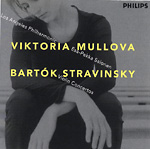Some recordings of Bartok’s Violin Concerto emphasize the work’s romantic and lyrical tendencies, while others play up its abrasive and acerbic nature. Of the former approach, Gil Shaham and Pierre Boulez make for surprising advocates; Anne-Sophie Mutter and Seiji Ozawa occupy the middle ground, while Viktoria Mullova and Esa-Pekka Salonen clearly stake out the latter. Mullova boldly strides into her first entrance bearing a full, resonant tone that sounds bracing after Shaham’s tenderness. Her confidence carries into the rapid passages that follow, allowing her to execute the difficult runs with razor-sharp precision and intonation. You can tell this is going to be a take-no-prisoners performance, and Mullova delivers the goods. However, instead of this being a straight-ahead modernist interpretation, Mullova plays Bartok’s concerto in the baroque style, making it sound, especially in the cleanly phrased and articulated first movement cadenza, like a concerto by Vivaldi. She does allow herself some tenderness in the Andante tranquillo, but this remains within the confines of her overall conception. The finale points up the Vivaldi allegory even more vividly as Mullova negotiates the hair-raising passages with elegant, stunning virtuosity. The end of the piece yields another surprise: Mullova has chosen Bartok’s alternate ending, which leaves out the violin in favor of a showcase for the brass, blazingly played by the Los Angeles Philharmonic, who, with Salonen, join Mullova in a perfect partnership. This is an enormously captivating performance, one to place alongside Mutter and Shaham, both on Deutsche Grammophon.
Stravinsky’s concerto already is in the neo-classical vein, so it’s no surprise that Mullova approaches this work in a fashion similar to the Bartok, though she softens her tone to a degree, making the most of the lyrical passages and the double-stops on those wonderful Stravinskian chords. Cho-Liang Lin, also accompanied by Esa-Pekka Salonen and the LAPO on Sony Classical, is more playful with the jazzy rhythms and appears to be having more fun. Which brings us to the matter of the sound. Sony places the soloist and orchestra in what sounds like a natural acoustic. Apparently this wasn’t good enough for Philips, who seemed to prefer placing a microphone inside the violin itself, making it sound more like a violinosaurus, thereby eroding all sense of realism. Given the solidity and power of Mullova’s tone, this was hardly necessary.
































